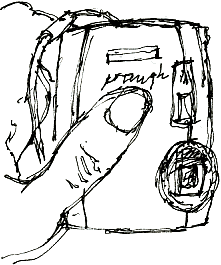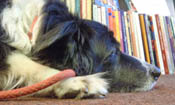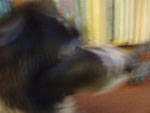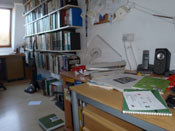Tough Guy
Richard Bell's Wild West Yorkshire Nature Diary, Tuesday, 2nd March 2010
previous | home
page | this month | e-mail
richard | next

 I'M
IMPRESSED with my new digital camera; the new model of the Olympus µ
Tough 3000. I've spent some time deciding what sort of camera to go
for; if the ultimate in image quality and versatility had been my main considerations
I think I would have gone for a Canon EOS 500D SLR but I realise
that for me it's more important to have a camera that I'll take with me everywhere;
one that will always be in my artbag along with my little box of watercolours.
Although the Tough 3000 is only the size of a bar of soap it will handle all
the landscapes, macro shots and even movies that I'm likely to need for my publications
and websites. And the quality is astonishing anyway; I feel that it gives better
results than those I used to get with my much loved, much used, Pentax
Spotmatic, my 35mm SLR from the 1970s.
I'M
IMPRESSED with my new digital camera; the new model of the Olympus µ
Tough 3000. I've spent some time deciding what sort of camera to go
for; if the ultimate in image quality and versatility had been my main considerations
I think I would have gone for a Canon EOS 500D SLR but I realise
that for me it's more important to have a camera that I'll take with me everywhere;
one that will always be in my artbag along with my little box of watercolours.
Although the Tough 3000 is only the size of a bar of soap it will handle all
the landscapes, macro shots and even movies that I'm likely to need for my publications
and websites. And the quality is astonishing anyway; I feel that it gives better
results than those I used to get with my much loved, much used, Pentax
Spotmatic, my 35mm SLR from the 1970s.
The close-up of the penny (right), is
just a small cropped portion of the image and even then I've reduced its size
or it would have stretched across most of this page.

 It's
fine for photographing sleeping dogs, like Sox the border collie
at the Rickaro Bookshop but the slight delay on the shutter means that it's
almost impossible to catch a particular moment when the dog is awake. Every
time I tried she moved her head to see what was going on in another corner of
the shop. For pets, wildlife photography or for candid shots of people you'd
probably be more successful with digital SLR which takes a photograph the instant
you press the shutter release button.
It's
fine for photographing sleeping dogs, like Sox the border collie
at the Rickaro Bookshop but the slight delay on the shutter means that it's
almost impossible to catch a particular moment when the dog is awake. Every
time I tried she moved her head to see what was going on in another corner of
the shop. For pets, wildlife photography or for candid shots of people you'd
probably be more successful with digital SLR which takes a photograph the instant
you press the shutter release button.

There's a panorama setting which works well; the scene is stitched
together in the camera as soon as you've taken the three shots required, taking
advantage of the visual guide. On this shot of the plantation at Langsett,
I had difficulty trying to find the join when I took the photographs as one
tree looks so much like another but the camera stitched them together seamlessly.

 This
photograph of my studio is the first that I took with the camera but I will
no doubt be featuring many more.
This
photograph of my studio is the first that I took with the camera but I will
no doubt be featuring many more.
Back to Basics
I'm not so delighted with the way my desktop publishing software
is behaving on my new Windows 7 computer; Serif PagePlus X4
continues to be abstruse when it comes to selecting text or moving text boxes
around (the ghost trails, right, are merely annoying but the selection bugs
make the program unpredictable and painfully slow to use) despite all the
help I've had from the PagePlus forum and from Serif's technical department.
When I've got the time I'll attempt to find an alternative, such as the free
open source Scribus but
I'd need to spend a lot of time getting familiar with it. Microsoft
Publisher doesn't output PDF files, so that's no good to me, and my
old version of Freehand can't make itself understood by my
new laser printer.
However there is a solution to the similar problems that I've
had with Serif WebPlus X4; I'm enjoying going back to my old
web design program Dreamweaver MX which surprisingly seems
very stable with Windows 7, even though it dates from 2002. Because it's such
an old program I've been able to order, for just a few pounds, the colourful
introduction to the program Teach Yourself Visually Dreamweaver MX
and the more comprehensive Dreamweaver MX; The Missing Manual.
The great thing about WebPlus is you don't have to worry
about the code, WebPlus takes care of all that for you, but the great
thing about Dreamweaver is that it encourages you to keep an eye on
the code - in fact you could design in code quite easily if you preferred. For
this long running Wild West Yorkshire website with it's thousands of
image files, Dreamweaver makes it much easier to insert previously
used images.
. . . having just written all that in praise of Dreamweaver,
the program promptly crashed!
previous | home
page | this month | e-mail
richard | next

 I'M
IMPRESSED with my new digital camera; the new model of the Olympus µ
Tough 3000. I've spent some time deciding what sort of camera to go
for; if the ultimate in image quality and versatility had been my main considerations
I think I would have gone for a Canon EOS 500D SLR but I realise
that for me it's more important to have a camera that I'll take with me everywhere;
one that will always be in my artbag along with my little box of watercolours.
Although the Tough 3000 is only the size of a bar of soap it will handle all
the landscapes, macro shots and even movies that I'm likely to need for my publications
and websites. And the quality is astonishing anyway; I feel that it gives better
results than those I used to get with my much loved, much used, Pentax
Spotmatic, my 35mm SLR from the 1970s.
I'M
IMPRESSED with my new digital camera; the new model of the Olympus µ
Tough 3000. I've spent some time deciding what sort of camera to go
for; if the ultimate in image quality and versatility had been my main considerations
I think I would have gone for a Canon EOS 500D SLR but I realise
that for me it's more important to have a camera that I'll take with me everywhere;
one that will always be in my artbag along with my little box of watercolours.
Although the Tough 3000 is only the size of a bar of soap it will handle all
the landscapes, macro shots and even movies that I'm likely to need for my publications
and websites. And the quality is astonishing anyway; I feel that it gives better
results than those I used to get with my much loved, much used, Pentax
Spotmatic, my 35mm SLR from the 1970s. 
 It's
fine for photographing sleeping dogs, like Sox the border collie
at the Rickaro Bookshop but the slight delay on the shutter means that it's
almost impossible to catch a particular moment when the dog is awake. Every
time I tried she moved her head to see what was going on in another corner of
the shop. For pets, wildlife photography or for candid shots of people you'd
probably be more successful with digital SLR which takes a photograph the instant
you press the shutter release button.
It's
fine for photographing sleeping dogs, like Sox the border collie
at the Rickaro Bookshop but the slight delay on the shutter means that it's
almost impossible to catch a particular moment when the dog is awake. Every
time I tried she moved her head to see what was going on in another corner of
the shop. For pets, wildlife photography or for candid shots of people you'd
probably be more successful with digital SLR which takes a photograph the instant
you press the shutter release button.

 This
photograph of my studio is the first that I took with the camera but I will
no doubt be featuring many more.
This
photograph of my studio is the first that I took with the camera but I will
no doubt be featuring many more.